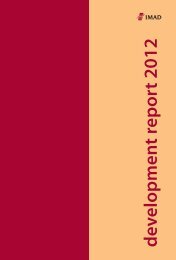Gonzalo C. Caprirolo and Marko Glažar Fiscal multipliers ... - UMAR
Gonzalo C. Caprirolo and Marko Glažar Fiscal multipliers ... - UMAR
Gonzalo C. Caprirolo and Marko Glažar Fiscal multipliers ... - UMAR
You also want an ePaper? Increase the reach of your titles
YUMPU automatically turns print PDFs into web optimized ePapers that Google loves.
Working Paper 2/2013<br />
<strong>Fiscal</strong> <strong>multipliers</strong> <strong>and</strong> policy mix during fiscal consolidation process: minimizing the impact<br />
of fiscal adjustment on economic activity (GDP)<br />
6<br />
12. With regard to the GDP dynamics in the aftermath of the permanent fiscal intervention the<br />
simulations indicate that recovery in GDP level is slower than under a temporary fiscal<br />
intervention in the cases of cuts in consumption <strong>and</strong> transfers <strong>and</strong> particularly in the case of<br />
investment which never recovers (Figure 4). This is because the shock affects also the GDP<br />
growth rate (Figure 5). The order of magnitude of the adverse effect of consolidation measures<br />
on GDP is similar than that in the case of temporary fiscal measures. Yet, the speed of reduction<br />
of negative impact on GDP due to cut in transfers is slower <strong>and</strong> equals that of VAT only in the<br />
four year after the shock (Figure 4). Appendix 1 summarizes the response of macroeconomic<br />
variables to the various shocks.<br />
Figure 4: Permanent shock (GDP level effect)<br />
Figure 5: Permanent shock (GDP growth rate)<br />
0<br />
-0,001<br />
2012 2013 2014 2015<br />
0,4<br />
0,2<br />
-0,002<br />
-0,003<br />
-0,004<br />
-0,005<br />
-0,006<br />
-0,007<br />
-0,008<br />
VAT_p<br />
G_p<br />
I_p<br />
TR_p<br />
0<br />
-0,2<br />
-0,4<br />
-0,6<br />
-0,8<br />
2012 2013 2014 2015<br />
VAT_p<br />
G_p<br />
I_p<br />
TR_p<br />
-0,009<br />
-1<br />
Source: Own calculations<br />
Source: Own calculations<br />
13. As discussed in Box 1 the results of the relative impact of permanent changes in various policy<br />
measures is robust to alternative calibration of two key parameters in the model influencing its<br />
dynamics <strong>and</strong> effects: The share of liquidity constrained households (LCH) in the economy <strong>and</strong><br />
the share of work force that sets its wage based on a forward looking view of inflation. In<br />
particular, according to Lepper et al (2011) the share of LCH is the single most relevant variable<br />
influencing the size of <strong>multipliers</strong>. Furthermore, in the current juncture given the recession <strong>and</strong><br />
stress in financial markets it is likely that <strong>multipliers</strong> are higher than in normal times (Auerbach<br />
<strong>and</strong> Gorodnichenko 2010; Baum et al 2012).<br />
Box 1: Sensitivity of fiscal <strong>multipliers</strong> to different share of liquidity constraint<br />
households (LCH) <strong>and</strong> of individuals setting their wage based on forward looking view of<br />
inflation (SFW)<br />
The two parameters affect the intensity <strong>and</strong> the dynamics of the response of economic activity<br />
to shocks as they result in frictions to real activity. The term liquidity constrained consumer<br />
refers to the consumer whose current consumption is determined by current income. On the<br />
other h<strong>and</strong> in the case of non-liquidity constrained, Ricardian, households their consumption<br />
decision is made on the basis of current <strong>and</strong> (expected) future income. A higher share of LCH<br />
tends to magnify the impact of a given shock as individuals cannot smooth out income<br />
fluctuations. The model is calibrated with a share of LCH of 40 % which is equivalent to two<br />
times the share of low skilled workers in the Slovenian workforce.<br />
The other parameter, the share of individuals setting their wage with a forward looking view of

















